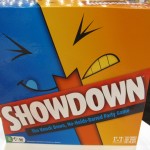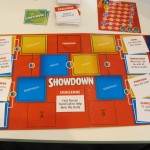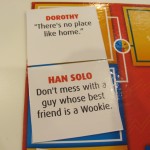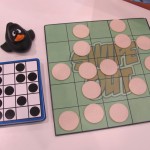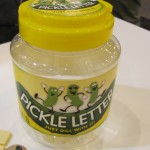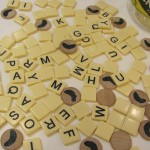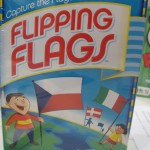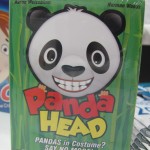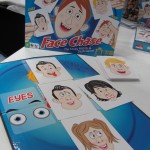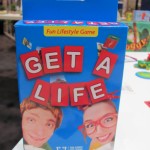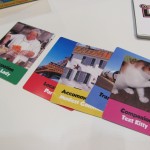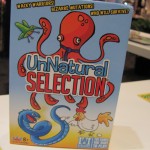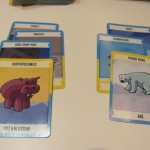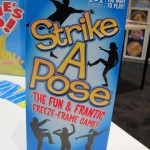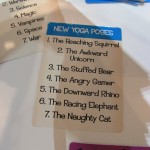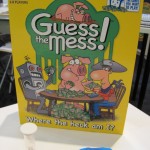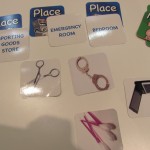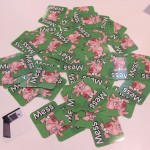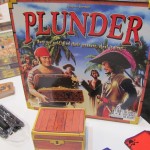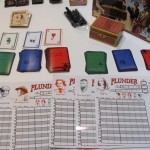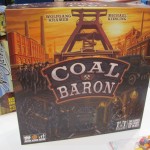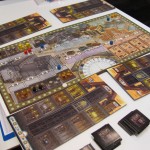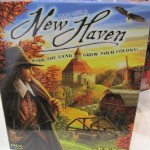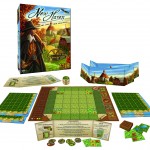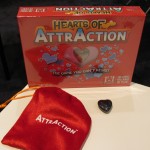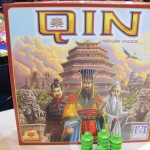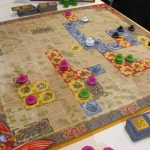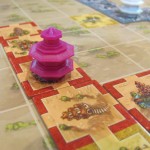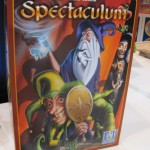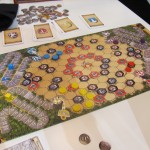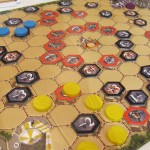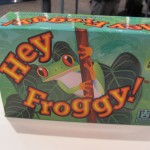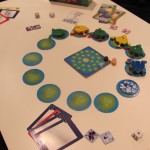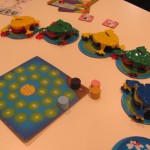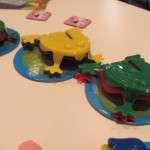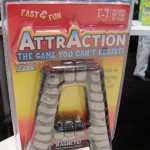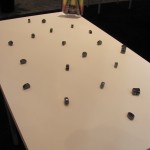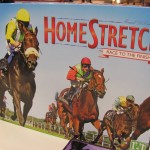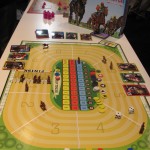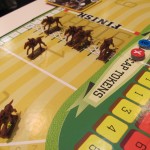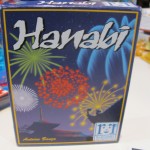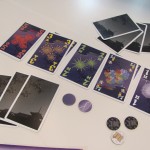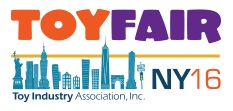 Though a company representative told me even more new games through 2016, four spring releases were being highlighted at the this week’s New York Toy Fair.
Though a company representative told me even more new games through 2016, four spring releases were being highlighted at the this week’s New York Toy Fair.
Showdown ($20) is an argue-over-famous-people party game with a tournament bracket sort of arrangement. To begin, players seed the bracket with the names of famous characters and personalities. Then for each round to narrow the competition, a challenge card is drawn and the players vote on which character fits the challenge best. Points are scored for correctly guessing who will survive each round, as well as for having contributed the character that comes out on top.
Swipe Out ($20) is a game of competitive pattern-matching. Players start each new round with a board filled with chips in a 5×5 grid. Then when a card is turned over, the goal is to pull chips, matching the card’s pattern of spots and spaces, and squeeze the rubber duck.
Pickle Letter ($16) is played with letter tiles but is not a word game. The tiles are initially just dumped on the table, with some naturally landing upside down. Players are then supposed to grab any matching pairs of letters they see (+1 point) but also call out “pickle” whenever the upright pairs appear to be exhausted. At that point, every player takes a pickle token (-3 points), 10 new tiles are turned over, and the process begins again. Along the way, anyone who makes a mistake also has to take a pickle token. The game ends when the pile is all pickled out.
And R&R’s wizard-duel card game, Spellcaster, is getting an expansion. Spellcaster Potions ($9) includes 20 new cards and a set of wood potion tokens. The new cards can substitute for some of the existing cards, with the potions used as fuel for some of the new spells.
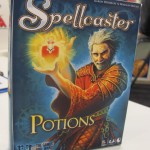
- Comments Off on Toy Fair 2016—R&R Games
Sound Effects for Board Games
29 Nov
Posted by David Miller as Classic Board Games, Electronic Games, Modern Board Games
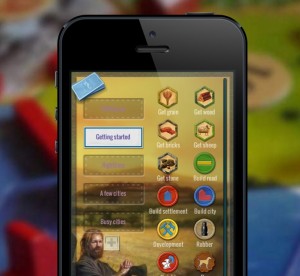 Is for you the board-gaming experience coming up short as a sensory experience? Syrinscape has you covered with a newly released sound-effects player for board games. The base player comes with “ooh”, “aah”, rolling dice, and other sounds for adding drama, mocking opponents, and underscoring victories.
Is for you the board-gaming experience coming up short as a sensory experience? Syrinscape has you covered with a newly released sound-effects player for board games. The base player comes with “ooh”, “aah”, rolling dice, and other sounds for adding drama, mocking opponents, and underscoring victories.
Like the company’s Fantasy and Sci-Fi players designed for roleplaying games, the Syrinscape Board Game Player provides much greater flexibility than just looping a prerecorded track. Users can set a selection of sound elements to play in a randomized pattern or mix them manually on-the-fly.
The Syrinscape Board Game Player is available for PCs (Windows and Mac), as well as Android and iOS mobile devices. Soundsets featuring individual sounds and preprogrammed environments for Chess, Casino, and Soduku are included. Additional soundsets are available at $10 each for Catan from Mayfair Games and Spellcaster and Spike from R&R Games. With the Catan set comes sounds for sheep, the knight and robber, sawing wood, a city marketplace, and more. The Spellcaster set includes unique sounds, in male and female sorcerer versions, for each of the games’ spells. The Spike set has a theme song and the sounds of trains and cargo.
- Comments Off on Sound Effects for Board Games
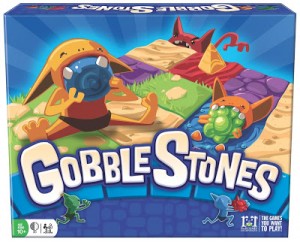 Releasing next month, GobbleStones from R&R Games is a family game where players are trying to get their goblins to gobble up the most stones in order to earn points. The more you eat, the fatter you get. The more you eat the slower you get. Find the right balance to become the fattest goblin by the end of the game.
Releasing next month, GobbleStones from R&R Games is a family game where players are trying to get their goblins to gobble up the most stones in order to earn points. The more you eat, the fatter you get. The more you eat the slower you get. Find the right balance to become the fattest goblin by the end of the game.
GobbleStones will retail for $24.99 and supports 2-4 players ages 10+ with a 30 minute play time.
 R & R Games brought to Gen Con advance copies of three family-style card games currently making their way in to retail.
R & R Games brought to Gen Con advance copies of three family-style card games currently making their way in to retail.
In Flipping Flags ($10) all players lay down cards simultaneously. Each has the flags of three different nations. The first player to find and call out a matching pair wins the round.
Panda Head ($10) is kind of a trick-taking game, except in each round, tricks one through six are just a set up for trick seven. Further, in trick seven the goal is actually to avoid taking the trick. As usual, the person who played the highest card takes the trick, but in this case the value of the highest card is the point value they score, and scoring points is bad. When a player reaches 21 points, their score is reset to the lowest score at the table. However, when they reach 21 a second time, they’re out of the game. The last player remaining is the winner.
The cards in Face Chase ($15—it comes with a board) are just a series of faces made from combinations of mouth, nose, eye, and hair styles. As soon a card is placed in the center, every player immediately tries to be the first to put down a card matching each of those characteristics. When all four are matched, the board is swiped clean and a new face is placed in the center. Simple enough, the first player to get rid of all their cards is the winner.
For the more advanced strategy gamer, R & R was promoting two titles, both priced at $50 and scheduled to premier at Essen.
Rome is a tile-placement game with triangle-shaped tiles. The points where tiles meet represent buildings and as more tiles are added to each point, the value of the building increases.
Mombasa, Dan of R & R described in very excited accounting terms. The game is about managing a plantation that produces sugar, coffee, and diamonds. It’s played by manipulating entries in public and private books, which Dan assured me is more exciting than it sounds.
- Comments Off on Gen Con 2015—R&R Games
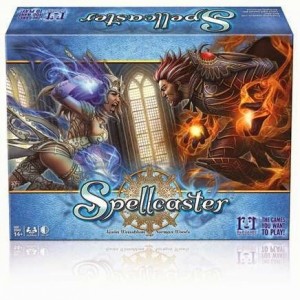 Arriving in November from R&R Games, SpellCaster is a 2-4 player game of mage combat. In the game you’ll use 60 different spells from four schools: Combat, Conjuring, Healing and Sorcery to try and force your opponents to run out of energy or to collect enough spell sapphires to knock them out.
Arriving in November from R&R Games, SpellCaster is a 2-4 player game of mage combat. In the game you’ll use 60 different spells from four schools: Combat, Conjuring, Healing and Sorcery to try and force your opponents to run out of energy or to collect enough spell sapphires to knock them out.
The game doesn’t seem to fit in R&R’s normal fare, and that’s not necessarily a bad thing. I’ve got my eye on this one. It looks like it may be a lighter, yet wholly enjoyable family fantasy game.
MSRP will be $19.95
- Comments Off on SpellCaster
 Last year R&R Games debuted for the American market Hanabi, which went on to win the Spiel des Jahres award. Will any of these repeat the feat?
Last year R&R Games debuted for the American market Hanabi, which went on to win the Spiel des Jahres award. Will any of these repeat the feat?
Get a Life ($12, available April) is a party game in which players assemble companion, accommodation, occupation, transportation, and location cards for either the best lifestyle or the worst. The thing is only a portion of a player’s cards are laid on the table, and also action cards allow players to steal or trade cards with each other. Thus, it can be a surprise when a player that appeared to be aiming for worst lifestyle ends up capturing best.
The cards that comprise UnNatural Selection ($11) have both contestant and attribute aspects. The contestant is a type of creature (e.g., hippopotamus and minotaur) and the attribute a wide range of adjectives (e.g., gassy, wearing a clown costume, and academic). Each round, players submit creatures of theirs to compete in a new contest (such as “winner of a potato sack race” or “fastest sausage stuffer”). Then they use their remaining cards to attach attributes to their and their opponents’ creatures. When all cards are played, the player who’s turn it is to judge that round, must choose one creature as the victor.
Strike a Pose ($20, available April) is a Charades-like action party game with a fashion theme. Players are supposed to pose in ways that represent clues within a category. For example, the Yoga Poses category includes “The Awkward Unicorn” and “The Angry Gamer”. The Trades category includes “Cook” and “Shepherd”.
With Guess the Mess ($20, available April) players make a messy pile of item cards, then have 30 seconds to grab as many items as they can that fit a location card. But that’s not the end. When the timer runs out, players pass their collected cards to each other and try to guess which of the locations was the intended fit. For example, do worms, chocolate, bullets, and scissors go in a bedroom or desk?
Plunder ($25) is a detailed deduction game with a pirate’s hidden-treasure theme. The goal in Plunder is to figure out on which island, at which marker, and protected with what trap is each other pirate’s treasure. As players draw cards, ask questions, and narrow the possibilities, they take notes with dry-erase markers. Cards marked with guesses are placed in a treasure chest.
Coal Baron ($45) is a worker-placement game about mining set in the late 1800s in Essen, Germany. For victory points, players need to fulfill contracts for particular types of coal. To get at that coal, though, they’ll first need to expand their mine tunnels and purchase coal carts. But the longer they delay at sending workers to mine, the more workers it will take to extract the needed coal.
Combining tile-placement and resource-management, New Haven ($40, available April) has players building villages in a New World colony. Stone, sheep, wheat, and timber resources are collected through the placement of tiles, and then used to attract tradesmen, build amenities, and entice more colonists.
Hearts of AttrAction ($20) is mostly alternative packaging to AttrAction. The rules are the same. The main difference is that the magnetic pieces are heart-shaped, which R&R reports make them more active.
- Comments Off on Toy Fair 2014—R&R Games
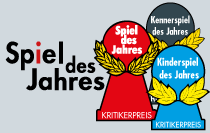 The 2013 Spiel des Jahres—German Game of the Year—has been awarded to Hanabi, designed by Antoine Bauza and published by Abacus Spiele in Germany. Hanabi is a cooperative card game, where each player can only see every other player’s cards.
The 2013 Spiel des Jahres—German Game of the Year—has been awarded to Hanabi, designed by Antoine Bauza and published by Abacus Spiele in Germany. Hanabi is a cooperative card game, where each player can only see every other player’s cards.
For the main Spiel des Jahres award, the jury of German journalists selects a game that it considers outstanding for “gaming amongst family and friends,” in other words, a game that works well for people who are not dedicated hobby gamers. The Kennerspiel des Jahres, or Expert Game of the Year, award was given to Legends of Andor designed by Michael Menzel and published in Germany by KOSMOS. The jury had also earlier awarded the Kinderspiel des Jahres, Children’s Game of the Year, to Der verzauberte Turm.
In an earlier statement, the chairman of the jury, Tom Felber, had said that the value of a game “does not depend on the box size.”
- Comments Off on 2013 Spiel des Jahres
![]()
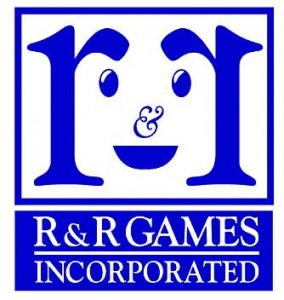 Definitely one of my favorite games of Toy Fair, R&R Games’ Qin is an Asian-themed tile laying game designed by Reiner Knizia. I can’t help but think of it as a multiplayer version of Knizia’s Carcassonne: The Castle, though there is more to it than that. When players lay tiles, they can place their pagodas to claim cities. And whereas it’s not uncommon to have one’s city stolen by an opponent, a city can be protected with a double-pagoda if it’s been expanded to cover five squares. Lost city spaces, of which several are printed on the board, go to the player with the largest contiguous city. Qin ends when either all the tiles are used or when there is no more open space on the board. The winner is the player with the most played pagodas (not the most claimed city spaces.) Qin retails for $40 and includes an advanced-play board on the reverse side.
Definitely one of my favorite games of Toy Fair, R&R Games’ Qin is an Asian-themed tile laying game designed by Reiner Knizia. I can’t help but think of it as a multiplayer version of Knizia’s Carcassonne: The Castle, though there is more to it than that. When players lay tiles, they can place their pagodas to claim cities. And whereas it’s not uncommon to have one’s city stolen by an opponent, a city can be protected with a double-pagoda if it’s been expanded to cover five squares. Lost city spaces, of which several are printed on the board, go to the player with the largest contiguous city. Qin ends when either all the tiles are used or when there is no more open space on the board. The winner is the player with the most played pagodas (not the most claimed city spaces.) Qin retails for $40 and includes an advanced-play board on the reverse side.
Another Knizia-designed title being shown by R&R was Spectaculum, a game about competition among traveling circuses. From the design perspective it’s a stock manipulation game, because circuses aren’t assigned to players, rather players buy and sell shares in all four of the circuses throughout the game. As the winner is the one with the greatest net worth at the end, the goal is to buy shares low and sell high. What I found particularly interesting was that moving the value of the circuses was accomplished by placing travel markers on the board, indicative of sending performers to visit various towns and villages. The retail price of Spectaculum is $30.
Now a third game from R&R, Hey Froggy, from a distance looked only like a very simple kids’ game. The game has cards, dice, colorful plastic frogs, and a board made of lily pads placed in a circle (retail price $16). After getting the demo, though, I can see that there’s a bit of strategy and some other interesting mechanics involved. First of all, the goal of the game is not to get the frogs to any particular destination. The goal is actually to play cards from your hand. The more cards you can play simultaneously, the more points you earn—a 1-card play is worth 1 point, a 2-card play 2 points, a 3-card play 4 points, and a 4-card play 7 points. However, you can only play cards that match the frogs that are on top of the stacks on the lily pads. Manipulating which frogs are on top is where the dice-rolling comes in.
For more straightforward fun, R&R had AttrAction. This game involves flicking and sliding magnets across a table. On your turn you slide a magnet across the table and get to keep any other magnets to which it sticks along the way. If however, it sticks to nothing or falls off the edge, you lose it. When the table is cleared of magnets, the player with the most wins.
And then there was Home Stretch, a horse-racing game where players roll dice to move their own horses but can also bet on other horses. And Hanabi, a cooperative card game with a deduction element—cards are held backwards so a player can’t see his own cards. And four more planned for release further out:
Plunder—a pirate-themed deduction game.
Strike a Pose—an activity game, where the players pose in the form of letters.
Guess the Mess—which involves grabbing cards that give clues to a location.
Unnatural Selection—a party game in which the players pile on descriptor cards (e.g., “smelly” or “lonely”) to both their and their opponent’s personality cards (e.g., “dragon” or “little girl”) in order to convince the judge to choose their personality in that round’s situation (e.g., “the first to be thrown overboard”).
- Comments Off on Toy Fair 2013—R&R Games
Trending
- Massdrop.com
- Oh the Irony—Illuminati Card Game Continues to Inspire Conspiracy Theorists
- Footprints, an Educational Ecology Game
- USPS Adds Board Game Flat Rate Box
- Home
- Baila, the Estonian Drinking Card Game
- Crystal Caste Wins Dice Patent Suit Against Hasbro
- Hasbro and Mattel Merger?
- Are Board Games Dangerous?
- Board Games Based on Hindu Mythology
Archives
Most Popular Articles
- Oh the Irony—Illuminati Card Game Continues to Inspire Conspiracy Theorists
- The 20 Most Valuable Vintage Board Games
- The Truth About Dominoes On Sunday in Alabama
- Sequence Game, and Variants
- USPS Adds Board Game Flat Rate Box
- Baila, the Estonian Drinking Card Game
- The 13 Most Popular Dice Games
- Are Board Games Dangerous?
- Guess Who? The Naked Version
- What Happened to the Jewel Royale Chess Set?
Recent Posts
- Toy Fair 2019—Breaking Games
- Talisman Kingdom Hearts Edition
- Toy Fair 2019—Winning Moves
- Toy Fair 2019—Games Workshop
- Toy Fair 2019—Star Wars Lightsaber Academy
- Toy Fair 2019—Stranger Things Games
- Toy Fair 2019—HABA
- Licensing Roundup
- Game Bandit
- 2018 A Difficult Year For Hasbro But Not For D&D Or MtG
Recent Comments
- on Toy Fair 2019—Winning Moves
- on Game Bandit
- on Second Look—Dungeons & Dragons Waterdeep Dragon Heist
- on Crowdfunding Highlights
- on Beyblade SlingShock
- on Game Bandit
- on Game Bandit
- on Watch This Game!, the Board Game Review Board Game
- on Second Look—Vampire: The Masquerade 5th Edition
- on Palladium Books Loses Robotech IP License, Cancels Five-Year-Overdue Robotech RPG Tactics Kickstarter

